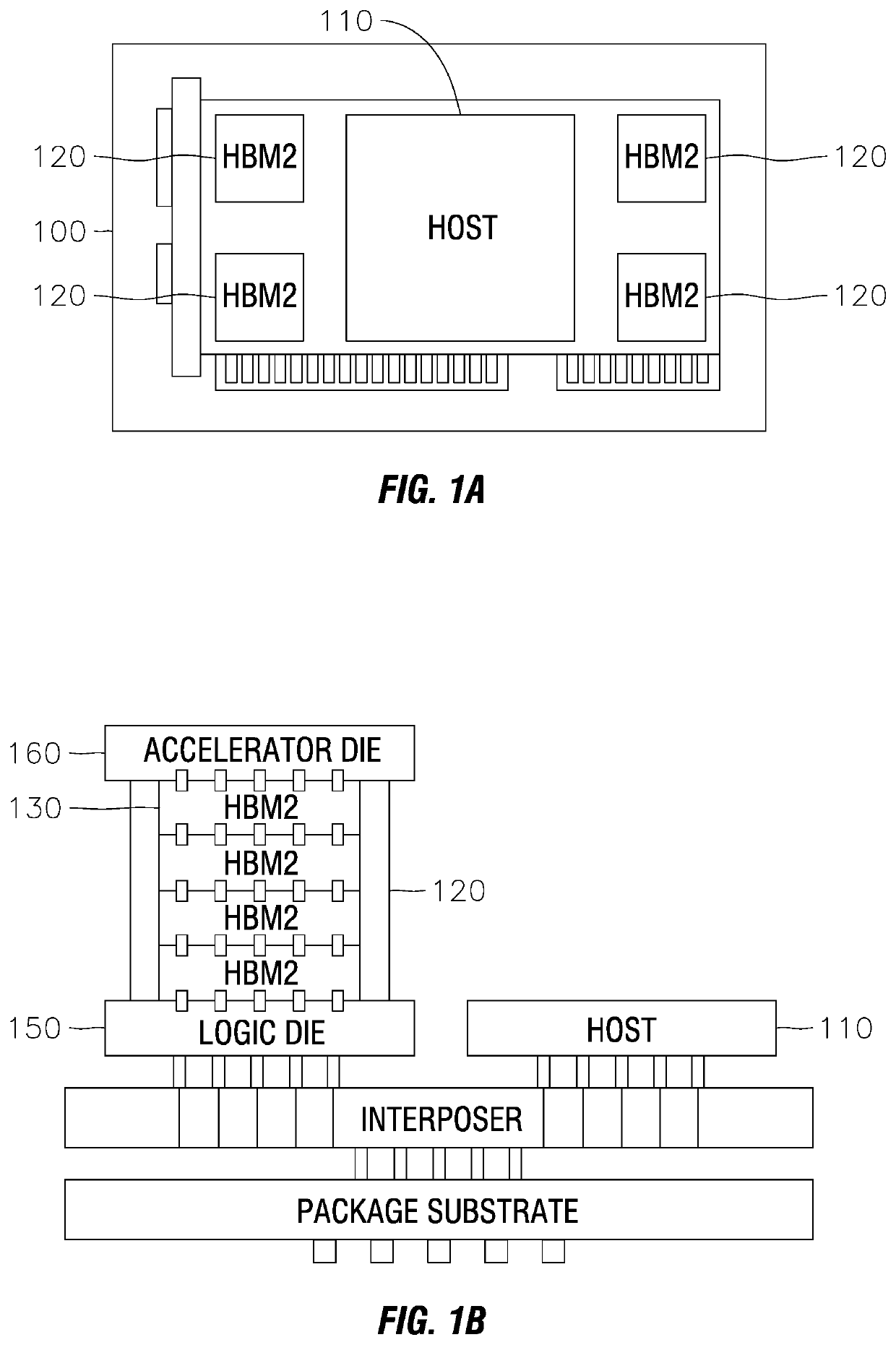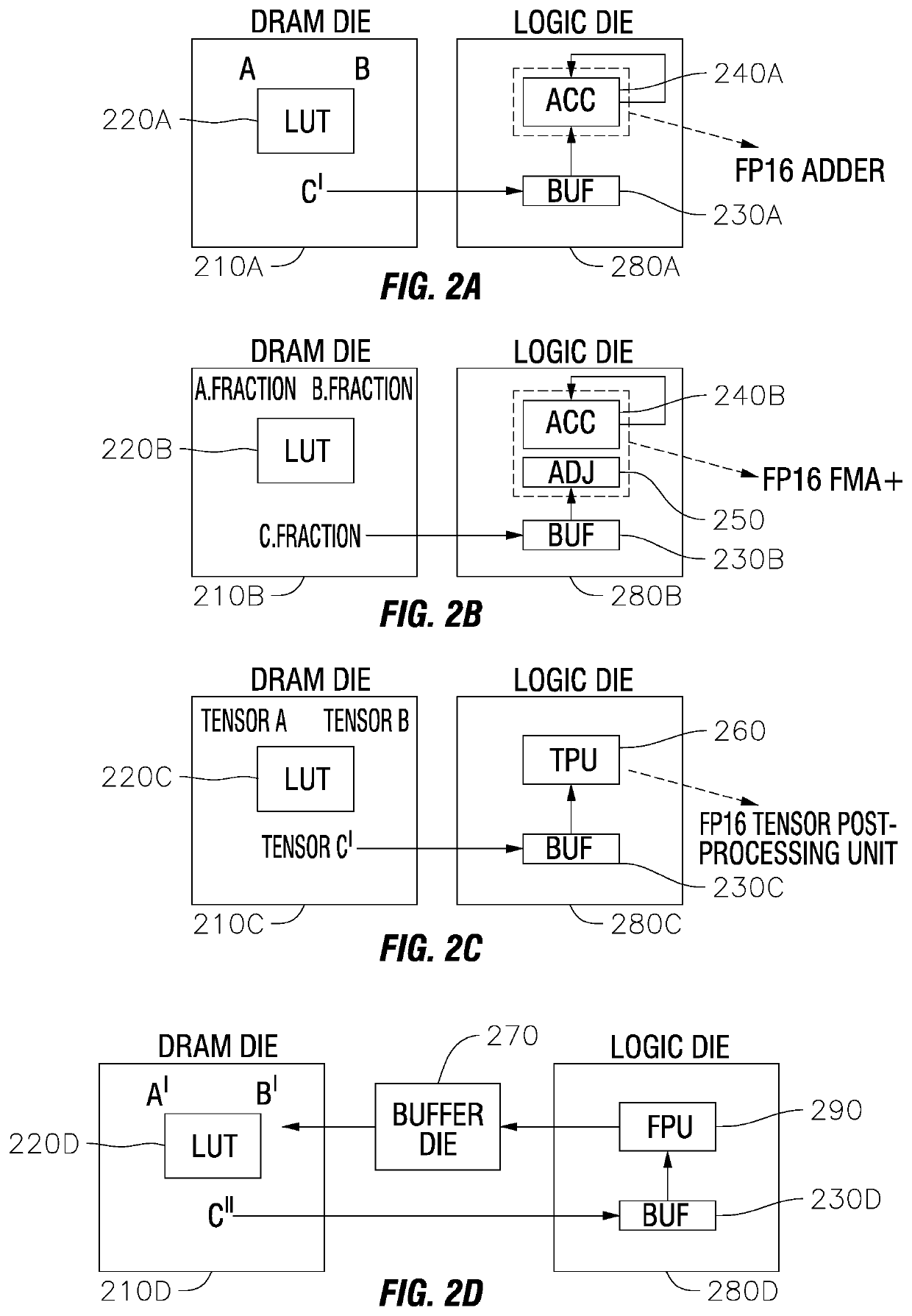Computing mechanisms using lookup tables stored on memory
a lookup mechanism and memory technology, applied in the direction of memory adressing/allocation/relocation, instruments, program control, etc., can solve the problems of increasing importance of energy-efficiency and low latency
- Summary
- Abstract
- Description
- Claims
- Application Information
AI Technical Summary
Benefits of technology
Problems solved by technology
Method used
Image
Examples
second embodiment
[0055]FIG. 2B illustrates the memory lookup mechanism. According to the present embodiment, the LUT 220B is located on the DRAM die 210B. The LUT 220B stores partial product multiplication results “C.fraction” of pre-computed floating point operations. The DRAM die 210B uses input values “A.fraction” and “B.fraction” to identify the result C.fraction in the LUTs. The A.fraction value represents the row address of the LUT and is a fraction part of input value A. The B.fraction represents the column address of the LUT and is a fraction part of input value B. According to the present embodiment, the A.fraction value and the B.fraction value may include fraction scalar floating point values.
[0056]In the present embodiment, the sign logic and exponent addition and subtraction logic are not implemented by the LUT to enable reduction in the size of the LUT. Because input values A.fraction and B.fraction are symmetrical, it is suitable to store only half of the results on the LUT 220B. The ...
third embodiment
[0058]FIG. 2C shows the memory lookup mechanism. According to the present embodiment, the LUT 220C is located on the DRAM die 210C. The LUT 220C contains tensor value results Tensor C′ of pre-computed floating point operations. The DRAM die 210C retrieves the tensor value results Tensor C′ from the LUT 220C. The DRAM die 210C uses the row address and column address of the LUT 220C to identify the tensor value results Tensor C′. For the multiplication of Tensor A and Tensor B, the row address is the concatenation of every element in each row of input value A, and the column address is every element in each column of input value B. Input value A and input value B may include tensor floating point values. The row address is equal to the number of elements multiplied by the length of the element. The row index and the column index are assumed to be unsigned integers. Because input values A and B are symmetrical, the LUT 220C only needs to store half of the tensor value results Tensor C′...
fourth embodiment
[0061]FIG. 2D displays the memory lookup mechanism. According to the present embodiment, the LUT 220D is located on the DRAM die 210D. Furthermore, the present embodiment also includes a buffer die 270. The LUT 220D contains real number value results C″ of pre-computed floating point operations. In the current embodiments, the real number value results C″ may include whole scalar floating point values. The DRAM die 210D retrieves the real number value results C″ from the LUT 220D. The DRAM die 210D uses the input values A′ and B′ to identify the real number value results C″ in the LUT 220D. The input value A′ represents the row address of the LUT 220D, and the input value B′ represents the column address of the LUT 220D. According to this embodiment, the input value A′ and input value B′ may include whole scalar floating point values.
[0062]The DRAM die 210D transmits the real number value result C″ to the buffer 230D located on the logic die 280D. The buffer 230D stores the real num...
PUM
 Login to View More
Login to View More Abstract
Description
Claims
Application Information
 Login to View More
Login to View More - R&D
- Intellectual Property
- Life Sciences
- Materials
- Tech Scout
- Unparalleled Data Quality
- Higher Quality Content
- 60% Fewer Hallucinations
Browse by: Latest US Patents, China's latest patents, Technical Efficacy Thesaurus, Application Domain, Technology Topic, Popular Technical Reports.
© 2025 PatSnap. All rights reserved.Legal|Privacy policy|Modern Slavery Act Transparency Statement|Sitemap|About US| Contact US: help@patsnap.com



